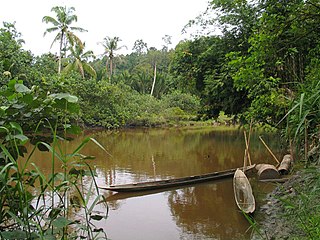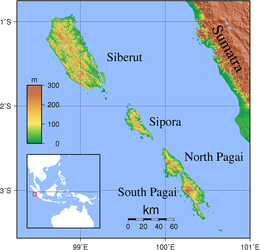
The Mentawai Islands Regency is a regency of West Sumatra Province which consists of a chain of about a hundred islands and islets approximately 150 kilometres off the western coast of Sumatra in Indonesia. They cover a land area of 6,033.76 km2 and had a population of 76,173 at the 2010 Census and 87,623 at the 2020 Census; the official estimate as of mid-2022 was 89,401 - comprising 46,431 males and 42,970 females. Siberut at 3,838.25 square kilometres is the largest of the islands. The other major islands are Sipura, North Pagai, and South Pagai. The islands lie off the Sumatran coast, across the Mentawai Strait. The indigenous inhabitants of the islands are known as the Mentawai people. The Mentawai Islands have become a noted destination for surfing, with over 40 boats offering surf charters to international guests.

The pig-tailed langur, monotypic in genus Simias, is a large Old World monkey, endemic to several small islands off the coast of Sumatra in Indonesia. Its face is black, its fur is black-brown and it has a relatively short tail. It is a diurnal species, feeding in the rainforest canopy on leaves, and to a lesser extent, fruit and berries. Little is known of its natural history, but it is heavily hunted, its populations have been declining rapidly and the International Union for Conservation of Nature has assessed its conservation status as being "critically endangered". It has been included on a list of the World's 25 Most Endangered Primates.

The Mentawai Islands rain forests is a tropical moist broadleaf forest ecoregion in Indonesia. It covers the Mentawai Islands, an archipelago in the Indian Ocean off the west coast of Sumatra. The islands have been separated from Sumatra since the mid-Pleistocene period, and their geographic isolation allowed the evolution of several endemic species, including 17 endemic mammals.

Sipora located off Sumatra in the West Sumatra Province of Indonesia, is the second-smallest and most developed of the four Mentawai Islands at only 651.55 km2. It had a population of 17,557 at the 2010 Census and 21,901 at the 2020 Census. The regency capital of the Mentawai Islands, Tuapejat, is found on Sipora. An estimated 10-15% of the original rainforest remains on this island.

Mentawai people are the native people of the Mentawai Islands about 100 miles from West Sumatra province, Indonesia. They live a semi-nomadic hunter-gatherer lifestyle in the coastal and rainforest environments of the islands and are also one of the oldest tribes in Indonesia. The Mentawai population is estimated to be about 64,000. The Mentawai tribe is documented to have migrated from Nias – a northern island – to the Mentawai islands, living in an isolated life for centuries until they encountered the Dutch in 1621. The ancestors of the indigenous Mentawai people are believed to have first migrated to the region somewhere between 2000 and 500 BCE. The Mentawai language belongs to the Austronesian language family. They follow their own animist belief system called Arat Sabulungan, that links the supernatural powers of ancestral spirits to the ecology of the rainforest. When the spirits are not treated well or forgotten, they might bring bad luck like illnesses and haunt those who forgot them. Mentawai also have very strong belief towards objects they think are holy. The people are characterized by their heavy spirituality, body art and their tendency to sharpen their teeth, a cultural practice tied to Mentawai beauty ideals. Mentawai tend to live in unison and peace with the nature around them because they believe that all things in nature have a form of spiritual essence.
The Mentawai language is an Austronesian language, spoken by the Mentawai people of the Mentawai Islands, West Sumatra, Indonesia.

The Pagai Island macaque, also known as the Pagai macaque or Bokkoi, is an Old World monkey endemic to the Mentawai Islands off the west coast of Sumatra. It is listed as critically endangered on the IUCN Red List due to its ever-shrinking habitat. Macaca pagensis formerly included the overall darker Siberut macaque as a subspecies, but this arrangement is polyphyletic, leading to the two being classified as separate species. Both were formerly considered subspecies of the southern pig-tailed macaque.
The Mentawai macaque or Mentawai island macaque may refer to:

South Pagai is one of the Mentawai Islands of the west coast of Sumatra in Indonesia. The island is south of North Pagai Island. The population figure given for South Pagai refers to South Pagai District alone. The largely unpopulated south portion of Sikakap District covers the southern part of North Pagai Island and the northern part of South Pagai Island, as well as various small islands in the strait between the two.
Koopman's pencil-tailed tree mouse is a species of arboreal rodent in the family Muridae. It is endemic to Pagai and Siberut islands in the Mentawai Islands, off the western coast of Sumatra in Indonesia. Its natural habitat is tropical primary lowland forest. It is threatened by habitat loss (logging).
The Pagai spiny rat is a species of rodent in the family Muridae. It is found only in the Mentawai Islands of Indonesia, on South Pagai, North Pagai, Sipora, and Siberut islands.
The Mentawai Archipelago rat is a species of rodent in the family Muridae. It is found only in the Mentawai Islands of Indonesia, on the islands of Siberut, Sipora, Pagai Utara, and Pagai Selatan.

The golden-bellied treeshrew is a treeshrew species within the Tupaiidae. It is also called Mentawai treeshrew as it is endemic to the Indonesian Mentawai islands of Sipora, North and South Pagai. It lives in forests, and is considered endangered due to habitat loss since the islands' forests are continuously logged.

The Mentawai langur is a species of primate in the family Cercopithecidae. It is endemic to the Mentawai Islands in Indonesia. Its natural habitat is subtropical or tropical dry forests. The Siberut langur was formerly considered a subspecies of the Mentawai langur.
The Mentawi flying squirrel is a species of rodent in the family Sciuridae. It is endemic to Indonesia where it is only known from the Mentawai Islands. Its natural habitat is lowland tropical primary forest below 500 m (1,600 ft) above sea level. It is threatened by habitat loss.
The fraternal squirrel is a species of rodent in the family Sciuridae. It is endemic to Indonesia, found only in the Mentawai Archipelago, located off the west coast of Sumatra.

The Siberut macaque is a vulnerable species of macaque, which is endemic to Siberut Island in Indonesia. It was formerly considered conspecific with the Pagai Island macaque which is overall paler in color, but this arrangement was polyphyletic. Both were formerly considered subspecies of the southern pig-tailed macaque.

The 2010 Mentawai earthquake occurred with a moment magnitude of 7.8 on 25 October off the western coast of Sumatra at 21:42 local time. The earthquake occurred on the same fault that produced the 2004 Indian Ocean earthquake. It was widely felt across the provinces of Bengkulu and West Sumatra and resulted in a substantial localized tsunami that struck the Mentawai Islands.

Sikakap is a sub-district on the Indonesian island of North Pagai, in the Mentawai Islands off Sumatra. The sub-district contains both Sikakap and Matobe, while Sikakap village incorporates the hamlets of Central Sikakap, East Sikakap and Sibaibai. Overall, the total population was 3,194 as of 2016. Also part of the sub-district is the Sikakap Strait between North and South Pagai, a designated Regional Marine Conservation Area. The Strait, an area of 3,960 hectares, has a coastal length of 19.79 kilometres (12.30 mi) and is a major contributor to West Sumatra's fishing industry.

Introduced to Indonesia in 1930s, surfing now attracts both Indonesian and foreign surfers to numerous locations across the nation.













